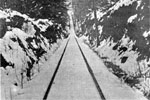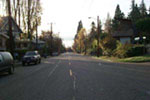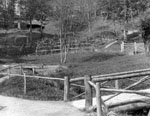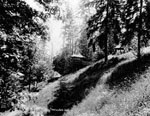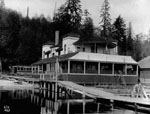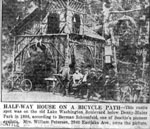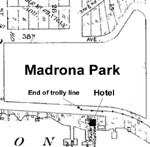
Before 1855:
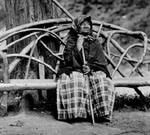 Native peoples inhabited the area around Puget Sound for many thousands of years. There were important villages to the north and south, but Madrona was probably mainly a transit point between Lake Washington and the interior and Puget Sound. People from many parts of what is now Washington State probably walked, rode on horses or canoed to Leschi where they took a trail to a village at what is now Pioneer Square. One direction they carried things like clams from the saltwater and the other such things as salmon and trout from fresh-water lakes and streams. People along Lake Washington were called the Hahchuahbsh or Lake People, taking their name from where they lived. They burned sections of the forest here every few years to encourage the blueberries they gathered and the deer they hunted for their food. These areas along with forests, marshes, lakes, bays and prairies made up the diverse environment that sustained them spiritually and physically. They had to care for it wisely or there might not be food, clothing, shelter and medicine the following year.
Native peoples inhabited the area around Puget Sound for many thousands of years. There were important villages to the north and south, but Madrona was probably mainly a transit point between Lake Washington and the interior and Puget Sound. People from many parts of what is now Washington State probably walked, rode on horses or canoed to Leschi where they took a trail to a village at what is now Pioneer Square. One direction they carried things like clams from the saltwater and the other such things as salmon and trout from fresh-water lakes and streams. People along Lake Washington were called the Hahchuahbsh or Lake People, taking their name from where they lived. They burned sections of the forest here every few years to encourage the blueberries they gathered and the deer they hunted for their food. These areas along with forests, marshes, lakes, bays and prairies made up the diverse environment that sustained them spiritually and physically. They had to care for it wisely or there might not be food, clothing, shelter and medicine the following year.
1852-1891:
The first permanent settlers of European descent came to live in the forests. In a series of agreements between local tribes and the federal and state governments after Washington statehood in 1889, native rights were relinquished, and settlers arrived in increasing numbers. After an 1856 attack on white settlers in Madrona/Leschi and the resulting hanging of Chief Leschi in 1858, the native presence ended. Much of Madrona/Denny Blaine was annexed to the city of Seattle.
1891-1893:
J. D. Lowman’s land company simultaneously developed Madrona Lakeside Park and an electric trolley car line twisting through the “deep wild canyon” where Madrona Drive now runs. Developers built a dance pavilion, bath houses, wooden swings, rustic benches and paths along the lake and through the wooded hillside. In 1892 a hotel and refreshment stand to service the trolleys and a wharf and warehouse with tracks for freight cars were built.
1900-1910: Madrona was a popular picnic destination during the summer and autumn.
1903-1909: Olmstad Brothers developed a system of parkways along Lake Washington from Bailey Peninsula (Seward Park) to the 1909 Alaska-Yukon-Pacific Expo at what is today the University of Washington. Their route was largely based on 25 miles of bicycle paths which had been constructed in 1892.
1908:
The city-owned Seattle Electric Co. bought the Madrona Park and trolley line, including the trolley wharf and warehouse just south of Spring St. The Park Board developed a boulevard through Madrona, using a pile trestle for the roadway, which curved outward along the shoreline to avoid the hotel and refreshment stand at the foot of the hill. The Park Board took over management of the hotel, boat house and dock, probably anticipating service to the upcoming nearby Expo.
1909: Lake Washington’s 14 steamboats were consolidated under Capt. John R
Anderson in the Lake Washington Steamboat Company, providing 15-minute service between Leschi, Madrona and Madison Park and the Expo Fairgrounds at today’s UW. They were known as the “Mosquito Fleet.”
1910-1912: Hotel removed. Lake frontage reclaimed by fill. Lakeside Avenue changed to Blaine Blvd. and relocated along the shoreline, approximately where the trestle had been before.
1915: Two tennis courts were built.
1916: Timber bulkhead along the shoreline was replaced in part with beach steps and concrete sea wall, which was extended to the north 25 years later to clean up the ragged waterfront along the picnic meadow.
1917: Lowering of the Lake level caused new fill to be sloped downward and extended.
1919: Frame bathhouse built; Blaine Blvd. along the Madrona Beach shoreline completed.
1925: The Boulevard relocated along the base of the hill.
1928: The “grand boulevard” from Seward Park to the Montlake Bridge was renamed Lake Washington Blvd.
1932: WPA replaced the comfort station built in 1911. The rustic shelters and benches on the park slope had disappeared, as had some of the less-frequently-used paths. WPA did some path restoration and cleaning of underbrush in the woods.
1948: The Parks Department planned a sailboat moorage adjacent to Madrona Beach, but community protest resulted in its being relocated to Leschi Park.
1959: Concession stand and comfort station combined in one new building.
1996-2014: Woods neighbors concerned about the invasive plants that had been replacing many native species in the Woods while it had been untended for 65 years, applied for and received a Small and Simple grant from the City. This was used to gather ideas and educate people in the neighborhood about what was in the Woods and what needed to be done to start restoring it. A strong volunteer group was formed to work with the local Starflower Foundation on an action plan to guide future efforts for restoration. The Master Action Plan was prepared and then approved by the Seattle Department of Parks and Recreation in May 1999. A partnership between the Friends of Madrona Woods, Starflower Foundation, the Parks Department and several other local governmental agencies, area schools, and other interested groups and individuals has brought the objectives in the action plan to fruition. These include revegetating the entire acreage with native plants, trail improvement, environmental education, and a stream daylighting.


